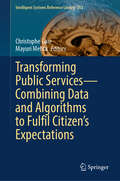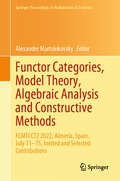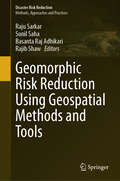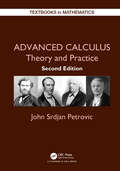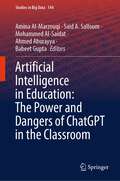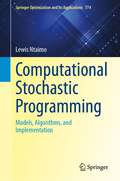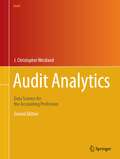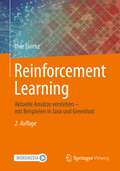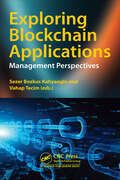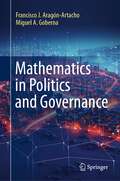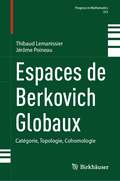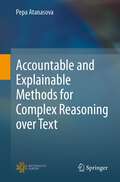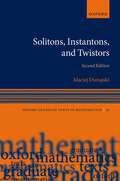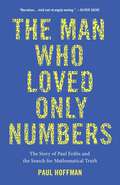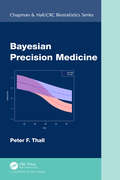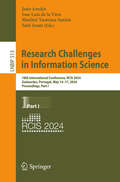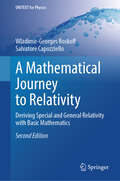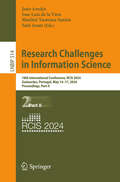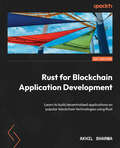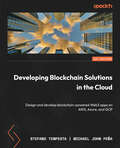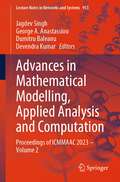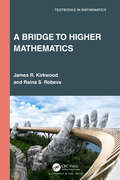- Table View
- List View
Transforming Public Services—Combining Data and Algorithms to Fulfil Citizen’s Expectations (Intelligent Systems Reference Library #252)
by Christophe Gaie Mayuri MehtaThis book provides a precise portrayal of the current trends and future perspectives of e-Government. It outlines new approaches that optimize public services across diverse sectors. Going beyond traditional boundaries, it offers mathematical models for public services supported by convincing case studies. This book significantly enhances various government services, such as education, healthcare, safety, security, and culture. It also strongly emphasizes safeguarding citizens' personal data, ensuring privacy, and obtaining explicit consent. Tailored for students and academics, the book is an invaluable reference for teaching graduate courses in e-Government, Process Modelling, or Artificial Intelligence. Its impact extends beyond the classroom; civil servants from all domains can find practical insights to navigate the ongoing modernization of public services. Even citizens curious about the transformation in their public services can find this book enlightening. Researchers working in the area of e-Governance can use this book to discover the recent developments in e-Government.
Functor Categories, Model Theory, Algebraic Analysis and Constructive Methods: FCMTCCT2 2022, Almería, Spain, July 11–15, Invited and Selected Contributions (Springer Proceedings in Mathematics & Statistics #450)
by Alexander MartsinkovskyThis volume comprises selected contributions by the participants of the second "Functor Categories, Model Theory, Algebraic Analysis and Constructive Methods" conference, which took place at the University of Almería, Spain, in July 2022.The conference was devoted to several seemingly unrelated fields: functor categories, model theory of modules, algebraic analysis (including linear control systems), and constructive category theory, to mention just a few. The fact that these fields are actually related is a very recent realization. The connections between these disciplines are changing in real time, and the goal of this volume is to provide an initial reference point for this emerging interdisciplinary field.Besides research articles, the volume includes two extended lectures: one on constructive methods in algebraic analysis and the other on the functorial approach to algebraic systems theory. Hence, in addition to its interestfor researchers, the volume will also be an invaluable resource for newcomers.
Geomorphic Risk Reduction Using Geospatial Methods and Tools (Disaster Risk Reduction)
by Raju Sarkar Sunil Saha Basanta Raj Adhikari Rajib ShawThis book explores the use of advanced geospatial techniques in geomorphic hazards modelling and risk reduction. It also compares the accuracy of traditional statistical methods and advanced machine learning methods and addresses the different ways to reduce the impact of geomorphic hazards.In recent years with the development of human infrastructures, geomorphic hazards are gradually increasing, which include landslides, flood and soil erosion, among others. They cause huge loss of human property and lives. Especially in mountainous, coastal, arid and semi-arid regions, these natural hazards are the main barriers for economic development. Furthermore, human pressure and specific human actions such as deforestation, inappropriate land use and farming have increased the danger of natural disasters and degraded the natural environment, making it more difficult for environmental planners and policymakers to develop appropriate long-term sustainability plans. The most challenging task is to develop a sophisticated approach for continuous inspection and resolution of environmental problems for researchers and scientists. However, in the past several decades, geospatial technology has undergone dramatic advances, opening up new opportunities for handling environmental challenges in a more comprehensive manner.With the help of geographic information system (GIS) tools, high and moderate resolution remote sensing information, such as visible imaging, synthetic aperture radar, global navigation satellite systems, light detection and ranging, Quickbird, Worldview 3, LiDAR, SPOT 5, Google Earth Engine and others deliver state-of-the-art investigations in the identification of multiple natural hazards. For a thorough examination, advanced computer approaches focusing on cutting-edge data processing, machine learning and deep learning may be employed. To detect and manage various geomorphic hazards and their impact, several models with a specific emphasis on natural resources and the environment may be created.
Advanced Calculus: Theory and Practice (Textbooks in Mathematics #12)
by John PetrovicAdvanced Calculus: Theory and Practice, Second Edition offers a text for a one- or two-semester course on advanced calculus or analysis. The text improves students’ problem-solving and proof-writing skills, familiarizes them with the historical development of calculus concepts, and helps them understand the connections among different topics. The book explains how various topics in calculus may seem unrelated but have common roots. Emphasizing historical perspectives, the text gives students a glimpse into the development of calculus and its ideas from the age of Newton and Leibniz to the twentieth century. Nearly 300 examples lead to important theorems.Features of the Second Edition: Improved Organization. Chapters are reorganized to address common preferences. Enhanced Coverage of Axiomatic Systems. A section is added to include Peano’s system of axioms for the set of natural numbers and their use in developing the well-known properties of the set N. Expanded and Organized Exercise Collection. There are close to 1,000 new exercises, many of them with solutions or hints. Exercises are classified based on the level of difficulty. Computation-oriented exercises are paired and solutions or hints provided for the odd-numbered questions. Enrichment Material. Historical facts and biographies of over 60 mathematicians. Illustrations. Thirty-five new illustrations are added in order to guide students through examples or proofs. About the Author:John Srdjan Petrovic is a professor at Western Michigan University.
Artificial Intelligence in Education: The Power and Dangers of ChatGPT in the Classroom (Studies in Big Data #144)
by Amina Al-Marzouqi Said A. Salloum Mohammed Al-Saidat Ahmed Aburayya Babeet GuptaThis book aims to bring together a collection of innovative and cutting-edge research that addresses the various challenges in the application and theoretical aspects of ChatGPT in education. ChatGPT is a large language model developed by OpenAI that has the ability to generate human-like text based on a prompt. This has significant potential for use in the field of education, as it allows for the creation of personalized, interactive learning experiences, automating assessment and grading, and more. In e-learning, ChatGPT is used to provide instant feedback and support to students, as well as generate interactive conversations in the target language for language learning. It is also integrated with existing learning management systems and educational technology platforms to enhance their capabilities. In research, ChatGPT is used for natural language processing and sentiment analysis to gather insights on student learning experiences and educational outcomes. However, it is important to note that there are also ethical and privacy concerns that come with using language models like ChatGPT in education, such as data protection and the potential for bias. Overall, the use of ChatGPT in education has the potential to revolutionize the way we learn, teach, and access information. The book seeks to publish original manuscripts that cover a broad range of topics, from the development of new chatbot technologies and their integration into the classroom, to the examination of the ethical and pedagogical implications of these systems. By compiling the latest developments in the field and highlighting new areas for exploration, this book provides valuable insights and perspectives for researchers, educators, and practitioners working in the field of ChatGPT and education. The ultimate goal is to advance the understanding of ChatGPT and its role in education and to promote its effective and responsible use in the classroom and beyond.
Computational Stochastic Programming: Models, Algorithms, and Implementation (Springer Optimization and Its Applications #774)
by Lewis NtaimoThis book provides a foundation in stochastic, linear, and mixed-integer programming algorithms with a focus on practical computer algorithm implementation. The purpose of this book is to provide a foundational and thorough treatment of the subject with a focus on models and algorithms and their computer implementation. The book’s most important features include a focus on both risk-neutral and risk-averse models, a variety of real-life example applications of stochastic programming, decomposition algorithms, detailed illustrative numerical examples of the models and algorithms, and an emphasis on computational experimentation. With a focus on both theory and implementation of the models and algorithms for solving practical optimization problems, this monograph is suitable for readers with fundamental knowledge of linear programming, elementary analysis, probability and statistics, and some computer programming background. Several examples of stochastic programming applications areincluded, providing numerical examples to illustrate the models and algorithms for both stochastic linear and mixed-integer programming, and showing the reader how to implement the models and algorithms using computer software.
Audit Analytics: Data Science for the Accounting Profession (Use R!)
by J. Christopher WestlandThis book, using R and RStudio, demonstrates how to render an audit opinion that is legally and statistically defensible; analyze, extract, and manipulate accounting data; build a risk assessment matrix to inform the conduct of a cost-effective audit program; and more. Today, information technology plays a pivotal role in financial control and audit: most financial data is now digitally recorded and dispersed among servers, clouds and networks over which the audited firm has no control. Additionally, a firm’s data—particularly in the case of finance, software, insurance and biotech firms—comprises most of the audited value of the firm. Financial audits are critical mechanisms for ensuring the integrity of information systems and the reporting of organizational finances. They help avoid the abuses that led to passage of legislation such as the Foreign Corrupt Practices Act (1977), and the Sarbanes-Oxley Act (2002). Audit effectiveness has declined over the past two decades, as auditor skillsets have failed to keep up with advances in information technology. Information and communication technology lie at the core of commerce today and are integrated in business processes around the world. This book is designed to meet the increasing need of audit professionals to understand information technology and the controls required to manage it. This 2nd edition includes updated code and test. Machine learning, AI, and SEC’s EDGAR data are also, improved and updated. The material included focuses on the requirements for annual Securities and Exchange Commission audits (10-K) for listed corporations. These represent the benchmark auditing procedures for specialized audits, such as internal, governmental, and attestation audits. Many examples reflect the focus of the 2024 CPA exam, and the data analytics-machine learning approach will be central to the AICPA’s programs, in the near future.
Reinforcement Learning: Aktuelle Ansätze verstehen – mit Beispielen in Java und Greenfoot
by Uwe LorenzIn uralten Spielen wie Schach oder Go können sich die brillantesten Spieler verbessern, indem sie die von einer Maschine produzierten Strategien studieren. Robotische Systeme üben ihre Bewegungen selbst. In Arcade Games erreichen lernfähige Agenten innerhalb weniger Stunden übermenschliches Niveau. Wie funktionieren diese spektakulären Algorithmen des bestärkenden Lernens? Mit gut verständlichen Erklärungen und übersichtlichen Beispielen in Java und Greenfoot können Sie sich die Prinzipien des bestärkenden Lernens aneignen und in eigenen intelligenten Agenten anwenden. Greenfoot (M.Kölling, King’s College London) und das Hamster-Modell (D.Bohles, Universität Oldenburg) sind einfache, aber auch mächtige didaktische Werkzeuge, die entwickelt wurden, um Grundkonzepte der Programmierung zu vermitteln. Wir werden Figuren wie den Java-Hamster zu lernfähigen Agenten machen, die eigenständig ihre Umgebung erkunden. Die zweite Auflage enthält neue Themen wie "Genetische Algorithmen" und "Künstliche Neugier" sowie Korrekturen und Überarbeitungen.
Exploring Blockchain Applications: Management Perspectives
In this book, the development process of blockchain algorithms and examples of their applications in different sectors are explored. The opportunities and challenges of blockchain implementations that arise in making technological innovations usable in corporate structures are discussed. In this respect, the book aims to deal with both the conceptual framework and the real challenges and opportunities encountered in practice regarding the blockchain applications. It is tried to contribute to the literature by presenting practical blockchain application suggestions to the readers on a scientific basis.It is a fact that blockchain technology is considered one of the most disruptive and revolutionary innovations after the invention of the internet. Blockchain technology, which was first used for cross-border payments, is coming up with a new application area in a different sector every day. The main purpose of Blockchain-based systems is to spread the "trust" service provided by a central intermediary to machines in transactions between two parties. Thus, it removes the need for this trust from the monopoly of a single intermediary. Blockchain implementation scenarios are to establish math-based trust in an untrusted environment.While exploring the complexity of blockchain applications in different sectors, the emerging risks are also examined from a management perspective. In particular, it is aimed to be a key work that the management levels of the enterprises can benefit from in the decision-making processes.It will be seen that blockchain technologies will be used unlimitedly in design, planning, management and decision making. This book will also introduce new visions for practitioners to use different blockchain technologies and methodologies to face problems.
Exploring Blockchain Applications: Management Perspectives
by Sezer Bozkus Kahyaoglu Vahap TecimIn this book, the development process of blockchain algorithms and examples of their applications in different sectors are explored. The opportunities and challenges of blockchain implementations that arise in making technological innovations usable in corporate structures are discussed. In this respect, the book aims to deal with both the conceptual framework and the real challenges and opportunities encountered in practice regarding the blockchain applications. It is tried to contribute to the literature by presenting practical blockchain application suggestions to the readers on a scientific basis.It is a fact that blockchain technology is considered one of the most disruptive and revolutionary innovations after the invention of the internet. Blockchain technology, which was first used for cross-border payments, is coming up with a new application area in a different sector every day. The main purpose of Blockchain-based systems is to spread the "trust" service provided by a central intermediary to machines in transactions between two parties. Thus, it removes the need for this trust from the monopoly of a single intermediary. Blockchain implementation scenarios are to establish math-based trust in an untrusted environment.While exploring the complexity of blockchain applications in different sectors, the emerging risks are also examined from a management perspective. In particular, it is aimed to be a key work that the management levels of the enterprises can benefit from in the decision-making processes.It will be seen that blockchain technologies will be used unlimitedly in design, planning, management and decision making. This book will also introduce new visions for practitioners to use different blockchain technologies and methodologies to face problems.
Mathematics in Politics and Governance
by Francisco J. Aragón-Artacho Miguel A. GobernaThis book presents the mathematical tools that politicians use to make rational decisions about health, education, culture, economy, finance, transportation, and national defense for their citizens. The selection of topics addressed is based on the experiences of four veteran politicians who have doctorates or master’s degrees in mathematics. The exposition also considers the mathematical tools used by politicians to capture votes or optimize their impact on the design of electoral districts, i.e., gerrymandering, without forgetting the mathematics applied to parliamentary activity and political science.Aimed at a general educated readership, a basic knowledge of mathematics is the only requisite to understanding most of the book. Certain sections, denoted in the book with a star, contain more advanced material and require some knowledge of undergraduate math. A later chapter is dedicated to applications and techniques of machine learning and the final chapter discusses a variety of cases where political decisions have affected mathematical development. Readers gravitating towards this book are those who are curious about the history of mathematics, including optimizers and mathematicians who would like to learn more about the historical roots of their discipline. There will also be strong appeal to mathematically-oriented economists, political scientists, and people generally interested in mathematics.Mathematics is – or it should be! – an important part of our culture. The impact of mathematics is sometimes silent, but a powerful one. The authors of this book did an incredible work in digging out areas of mathematical reasoning that pervades social and political life. Reading this book, we will all enrich our vision of mathematics’ value for society.(Nuno Crato, Professor of Applied Mathematics, University of Lisbon, former minister of Education and Science of Portugal 2011–2015)This monograph shows in an impressive way that mathematics can be very helpful in making and evaluating political decisions and that it is indispensable in the progressive penetration of all areas of society with scientific methods. This also includes politics. Not everything in politics can be justified or related to mathematics, but politics should not be made in contradiction to mathematical truths. For me, this is a central message of this publication.(Johanna Wanka, Professor of Applied Mathematics, Merseburg University of Applied Sciences, former Minister of Education and Research, Germany 2013–2018)
Espaces de Berkovich Globaux: Catégorie, Topologie, Cohomologie (Progress in Mathematics #353)
by Thibaud Lemanissier Jérôme PoineauCet ouvrage propose une contribution aux fondements de la théorie des espaces de Berkovich globaux. Cette approche récente à la géométrie analytique, qui mêle les théories classiques des espaces analytiques complexes et p-adiques, fournit un cadre géométrique naturel pour plusieurs théories arithmétiques, telle que la théorie d’Arakelov. Les auteurs suivent trois axes principaux, inexplorés au-delà de la dimension 1 : catégorie, topologie et cohomologie. En particulier, ils introduisent une notion de domaine affinoïde surconvergent, pour lequel sont valables les analogues des théorèmes de Tate et de Kiehl.This monograph contributes to the foundations of the theory of global Berkovich spaces. This recent approach of analytic geometry, which blends the known theories of complex and p-adic analytic spaces, provides a natural geometric framework for several arithmetic theories, such as Arakelov geometry. The authors focus on three main themes which have yet to be investigated beyond dimension 1 : category, topology, and cohomology. In particular, they introduce a notion of overconvergent affinoid domain where the analogues of Tate's and Kiehl's theorems hold.
Accountable and Explainable Methods for Complex Reasoning over Text
by Pepa AtanasovaThis thesis presents research that expands the collective knowledge in the areas of accountability and transparency of machine learning (ML) models developed for complex reasoning tasks over text. In particular, the presented results facilitate the analysis of the reasons behind the outputs of ML models and assist in detecting and correcting for potential harms. It presents two new methods for accountable ML models; advances the state of the art with methods generating textual explanations that are further improved to be fluent, easy to read, and to contain logically connected multi-chain arguments; and makes substantial contributions in the area of diagnostics for explainability approaches. All results are empirically tested on complex reasoning tasks over text, including fact checking, question answering, and natural language inference. This book is a revised version of the PhD dissertation written by the author to receive her PhD from the Faculty of Science, University ofCopenhagen, Denmark. In 2023, it won the Informatics Europe Best Dissertation Award, granted to the most outstanding European PhD thesis in the field of computer science.
Solitons, Instantons, and Twistors (Oxford Graduate Texts in Mathematics)
by Maciej DunajskiMost nonlinear differential equations arising in natural sciences admit chaotic behaviour and cannot be solved analytically. Integrable systems lie on the other extreme. They possess regular, stable, and well-behaved solutions known as solitons and instantons. These solutions play important roles in pure and applied mathematics as well as in theoretical physics where they describe configurations topologically different from vacuum. While integrable equations in lower space-time dimensions can be solved using the inverse scattering transform, the higher-dimensional examples of anti-self-dual Yang-Mills and Einstein equations require twistor theory. Both techniques rely on an ability to represent nonlinear equations as compatibility conditions for overdetermined systems of linear differential equations. The book provides a self-contained and accessible introduction to the subject. It starts with an introduction to integrability of ordinary and partial differential equations. Subsequent chapters explore symmetry analysis, gauge theory, vortices, gravitational instantons, twistor transforms, and anti-self-duality equations. The three appendices cover basic differential geometry, complex manifold theory, and the exterior differential system.
The Man Who Loved Only Numbers: The Story of Paul Erdos and the Search for Mathematical Truth
by Paul Hoffman"A funny, marvelously readable portrait of one of the most brilliant and eccentric men in history." --The Seattle Times Paul Erdos was an amazing and prolific mathematician whose life as a world-wandering numerical nomad was legendary. He published almost 1500 scholarly papers before his death in 1996, and he probably thought more about math problems than anyone in history. Like a traveling salesman offering his thoughts as wares, Erdos would show up on the doorstep of one mathematician or another and announce, "My brain is open." After working through a problem, he'd move on to the next place, the next solution. Hoffman's book, like Sylvia Nasar's biography of John Nash, A Beautiful Mind, reveals a genius's life that transcended the merely quirky. But Erdos's brand of madness was joyful, unlike Nash's despairing schizophrenia. Erdos never tried to dilute his obsessive passion for numbers with ordinary emotional interactions, thus avoiding hurting the people around him, as Nash did. Oliver Sacks writes of Erdos: "A mathematical genius of the first order, Paul Erdos was totally obsessed with his subject--he thought and wrote mathematics for nineteen hours a day until the day he died. He traveled constantly, living out of a plastic bag, and had no interest in food, sex, companionship, art--all that is usually indispensable to a human life."The Man Who Loved Only Numbers is easy to love, despite his strangeness. It's hard not to have affection for someone who referred to children as "epsilons," from the Greek letter used to represent small quantities in mathematics; a man whose epitaph for himself read, "Finally I am becoming stupider no more"; and whose only really necessary tool to do his work was a quiet and open mind. Hoffman, who followed and spoke with Erdos over the last 10 years of his life, introduces us to an undeniably odd, yet pure and joyful, man who loved numbers more than he loved God--whom he referred to as SF, for Supreme Fascist. He was often misunderstood, and he certainly annoyed people sometimes, but Paul Erdos is no doubt missed. --Therese Littleton
Bayesian Precision Medicine (Chapman & Hall/CRC Biostatistics Series)
by Peter F. ThallBayesian Precision Medicine presents modern Bayesian statistical models and methods for identifying treatments tailored to individual patients using their prognostic variables and predictive biomarkers. The process of evaluating and comparing treatments is explained and illustrated by practical examples, followed by a discussion of causal analysis and its relationship to statistical inference. A wide array of modern Bayesian clinical trial designs are presented, including applications to many oncology trials. The later chapters describe Bayesian nonparametric regression analyses of datasets arising from multistage chemotherapy for acute leukemia, allogeneic stem cell transplantation, and targeted agents for treating advanced breast cancer.Features: Describes the connection between causal analysis and statistical inference Reviews modern personalized Bayesian clinical trial designs for dose-finding, treatment screening, basket trials, enrichment, incorporating historical data, and confirmatory treatment comparison, illustrated by real-world applications Presents adaptive methods for clustering similar patient subgroups to improve efficiency Describes Bayesian nonparametric regression analyses of real-world datasets from oncology Provides pointers to software for implementation Bayesian Precision Medicine is primarily aimed at biostatisticians and medical researchers who desire to apply modern Bayesian methods to their own clinical trials and data analyses. It also might be used to teach a special topics course on precision medicine using a Bayesian approach to postgraduate biostatistics students. The main goal of the book is to show how Bayesian thinking can provide a practical scientific basis for tailoring treatments to individual patients.
Bayesian Precision Medicine (Chapman & Hall/CRC Biostatistics Series)
by Peter F. ThallBayesian Precision Medicine presents modern Bayesian statistical models and methods for identifying treatments tailored to individual patients using their prognostic variables and predictive biomarkers. The process of evaluating and comparing treatments is explained and illustrated by practical examples, followed by a discussion of causal analysis and its relationship to statistical inference. A wide array of modern Bayesian clinical trial designs are presented, including applications to many oncology trials. The later chapters describe Bayesian nonparametric regression analyses of datasets arising from multistage chemotherapy for acute leukemia, allogeneic stem cell transplantation, and targeted agents for treating advanced breast cancer.Features: Describes the connection between causal analysis and statistical inference Reviews modern personalized Bayesian clinical trial designs for dose-finding, treatment screening, basket trials, enrichment, incorporating historical data, and confirmatory treatment comparison, illustrated by real-world applications Presents adaptive methods for clustering similar patient subgroups to improve efficiency Describes Bayesian nonparametric regression analyses of real-world datasets from oncology Provides pointers to software for implementation Bayesian Precision Medicine is primarily aimed at biostatisticians and medical researchers who desire to apply modern Bayesian methods to their own clinical trials and data analyses. It also might be used to teach a special topics course on precision medicine using a Bayesian approach to postgraduate biostatistics students. The main goal of the book is to show how Bayesian thinking can provide a practical scientific basis for tailoring treatments to individual patients.
Research Challenges in Information Science: 18th International Conference, RCIS 2024, Guimarães, Portugal, May 14–17, 2024, Proceedings, Part I (Lecture Notes in Business Information Processing #513)
by João Araújo Jose Luis de la Vara Maribel Yasmina Santos Saïd AssarThis book constitutes the proceedings of the 18th International Conference on Research Challenges in Information Sciences, RCIS 2024, which took place in Guimarães, Portugal, during May 2024. The scope of RCIS is summarized by the thematic areas of information systems and their engineering; user-oriented approaches; data and information management; business process management; domain-specific information systems engineering; data science; information infrastructures, and reflective research and practice. The 25 full papers, 12 Forum and 5 Doctoral Consortium papers included in these proceedings were carefully reviewed and selected from 100 submissions. They were organized in topical sections as follows: Part I: Data and information management; conceptual modelling and ontologies; requirements and architecture; business process management; data and process science; security; sustainability; evaluation and experience studies Part II: Forum papers; doctoral consortium papers.
A Mathematical Journey to Relativity: Deriving Special and General Relativity with Basic Mathematics (UNITEXT for Physics)
by Wladimir-Georges Boskoff Salvatore CapozzielloThe 2nd edition of this textbook features more than 100 pages of new material, including four new chapters, as well as an improved discussion of differential geometry concepts and their applications. The textbook aims to provide a comprehensive geometric description of Special and General Relativity, starting from basic Euclidean geometry to more advanced non-Euclidean geometry and differential geometry. Readers will learn about the Schwarzschild metric, the relativistic trajectory of planets, the deflection of light, the black holes, and the cosmological solutions like de Sitter, Friedman-Lemaître-Robertson-Walker, and Gödel ones, as well as the implications of each of them for the observed physical world. In addition, the book provides step-by-step solutions to problems and exercises, making it an ideal introduction for undergraduate students and readers looking to gain a better understanding of Special and General Relativity. In this new edition, a wide discussion on metric-affine theories of gravity and equivalent formulations of General Relativity is reported. The aim is presenting also topics which could be useful for PhD students and researchers studying General Relativity from an advanced point of view.
Research Challenges in Information Science: 18th International Conference, RCIS 2024, Guimarães, Portugal, May 14–17, 2024, Proceedings, Part II (Lecture Notes in Business Information Processing #514)
by João Araújo Jose Luis de la Vara Maribel Yasmina Santos Saïd AssarThis book constitutes the proceedings of the 18th International Conference on Research Challenges in Information Sciences, RCIS 2024, which took place in Guimarães, Portugal, during May 2024. The scope of RCIS is summarized by the thematic areas of information systems and their engineering; user-oriented approaches; data and information management; business process management; domain-specific information systems engineering; data science; information infrastructures, and reflective research and practice. The 25 full papers, 12 Forum and 5 Doctoral Consortium papers included in these proceedings were carefully reviewed and selected from 100 submissions. They were organized in topical sections as follows: Part I: Data and information management; conceptual modelling and ontologies; requirements and architecture; business process management; data and process science; security; sustainability; evaluation and experience studies Part II: Forum papers; doctoral consortium papers.
Rust For Blockchain Application Development: Learn To Build Decentralized Applications On Popular Blockchain Technologies Using Rust
by Akhil SharmaRust For Blockchain Application Development: Learn To Build Decentralized Applications On Popular Blockchain Technologies Using Rust
by Akhil SharmaLearn to build decentralized applications on popular blockchain technologies using Rust
Developing Blockchain Solutions in the Cloud: Design And Develop Blockchain-powered Web3 Apps On Aws, Azure, And Gcp
by Stefano Tempesta and Michael John PeñaDesign and develop blockchain-powered Web3 apps on AWS, Azure, and GCP
Advances in Mathematical Modelling, Applied Analysis and Computation: Proceedings of ICMMAAC 2023 – Volume 2 (Lecture Notes in Networks and Systems #953)
by Jagdev Singh George A. Anastassiou Dumitru Baleanu Devendra KumarThis book gathers selected research articles presented in the “6th International Conference on Mathematical Modelling, Applied Analysis and Computation (ICMMAAC)”, held at JECRC University, Jaipur, during August 3–5, 2023. This book is focused on articles dealing with necessary theory and techniques in a balanced manner, and contributes towards solving mathematical problems arising in physics, engineering, chemistry, biological systems, medicine, networking system, control systems, environmental sciences, social issues of current interest and more. Annually held since 2018, the ICMMAAC conference aimed, in particular, to foster cooperation among practitioners and theoreticians in these fields. This proceedings is an invaluable resource for researchers, academicians and professionals associated or interested in current advances in different aspects of mathematical modelling, computational algorithms and analysis necessary for handling real-world problems.
A Bridge to Higher Mathematics (Textbooks in Mathematics)
by James R. Kirkwood Raina S. RobevaThe goal of this unique text is to provide an “experience” that would facilitate a better transition for mathematics majors to the advanced proof-based courses required for their major.If you feel like you love mathematics but hate proofs, this book is for you. The change from example-based courses such as Introductory Calculus to the proof-based courses in the major is often abrupt, and some students are left with the unpleasant feeling that a subject they loved has turned into material they find hard to understand.The book exposes students and readers to some fundamental content and essential methods of constructing mathematical proofs in the context of four main courses required for the mathematics major – probability, linear algebra, real analysis, and abstract algebra.Following an optional foundational chapter on background material, four short chapters, each focusing on a particular course, provide a slow-paced but rigorous introduction. Students get a preview of the discipline, its focus, language, mathematical objects of interest, and methods of proof commonly used in the field. The organization of the book helps to focus on the specific methods of proof and main ideas that will be emphasized in each of the courses.The text may also be used as a review tool at the end of each course and for readers who want to learn the language and scope of the broad disciplines of linear algebra, abstract algebra, real analysis, and probability, before transitioning to these courses.
